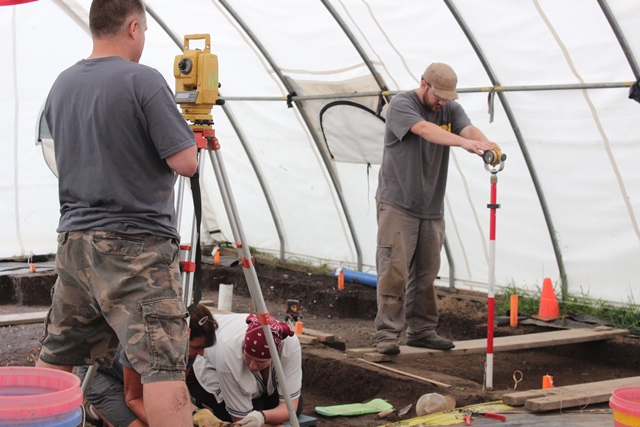|
Field School-
At this time, there will be
no field school at Johnson's Island Civil War Prison site.
We thank all those that
have participated over the years!

2015 Field School Excavating at Block 6-Prison Hospital

Students using their training in the
Total Station to Map Features in Block 6-2016 Field School.
The Center for Historic and Military
Archaeology at Heidelberg University is sponsoring a summer
field school at the historic Johnson's Island Civil War
Prison site. The program will run from Monday June 1st to Friday July3rd, 2015. Students will receive
6 semester hours of credit in ANT 250/251 (Archaeological
Field Methods/Experience).
Brief
overview of Johnson's Island Civil War Prison:
From
April 1862 until the end of the war, Johnson's Island Civil
War Military Prison functioned as the main Union depot for
Confederate Officers. Designed to hold approximately
2500 prisoners of war, Johnson's Island eventually
held up to 3200 at any one time. The overcrowding
resulted in the construction of new mess halls and to an expansion of the
prison compound. Expansion of the prison facilities
provides archaeologists with an opportunity to study changes
in the physical structure of the prison as well as in the
lifestyles of it's occupants. In comparison to the
thirty-one Union prisons, Johnson's Island is unique in its
purpose (housing Confederate Officers), in its military
garrison (recruited specifically for guard duties) and in
its condition (as an archaeological site). (For more on the
history of Johnson's Island, click
here.
 
2016 Field
School:
Since the
spring of 1989, Dr. Bush has been investigating the
Johnson's Island Civil War Prison. This site, located on a
small island in Sandusky Bay, Lake Erie (just north of Cedar
Point) held over 10,000 Confederate officers captured at
hundreds of battles during the Civil War. One of the unique
aspects of this Union prison is it only held Confederate
officers. Past research has allowed us to specifically
locate many of the special use areas of the prison. We have
conducted investigations at Blocks 2, 4, and 8-general
housing blocks and Block 6, the prison hospital. In the
mid-1990s, preliminary investigations were conducted at
Block 8. In 2010 we again explored both a latrine and the
building location of Block 8. In the past few years, we have
excavated half of the location of Block 8 as well as
completing the excavation of Feature 124, the later 1862
latrine. In 1994 we opened up Feature 14, an 1863 latrine
from Block 8. Our intent is to expose the remainder of
Feature 14 (the latrine) and continue its excavation. This
latrine was used in the latter part of 1863 by the occupants
of Block 8.
We spent several years at Blocks 4 and 6, developing a very
comprehensive collection of cultural materials from these
blocks. This year we are hoping to complete the entire Block
6, hospital, excavation. In 2015 we excavated the northwest
extension of Block 6, which we believe was the prison
hospitalís mess area. The area produced many items related
to food preparation as well as medical containers. The
excavations this year should give us a look at the northern
end of the building and complete our work at the hospital.
Finally, the research will continue in the laboratory with
the field school conducting preliminary analyses of
materials excavated. There will be two nights of laboratory
work each week. Additionally, we will have Mike Woshner
visit at the field school and provide an insightful
presentation of the use of hard rubber during the US Civil
War.
We have had the pleasure of using our work at Johnson's
Island as part of the Archaeology's Interactive Dig web
site. You can view years of our work at their web site.
http://interactive.archaeology.org/johnsonsisland/
We are offering a
five week field school (six credit hours) for graduate
students, undergraduate college students, graduating high
school seniors, incoming first year college students,
and non-traditional adult students for academic credit, and
for degree holding students who wish to gain field
experience or expand their knowledge. This is an
excellent opportunity to gain archaeological experience as
well as learn about the U.S. Civil War and the prison system. In addition to the
field experience, there will be laboratory sessions in the
archaeological laboratory on the Heidelberg University
campus.
Participants
in the field school will gain experience in basic excavation
techniques, on-site photography, the recording of
archaeological data, and the identification and conservation
of historic cultural materials. Students will work at the
site Monday through Friday (8:30-3:30) for five
weeks. Johnsonís Island is connected to the mainland through
a causeway built from Marblehead to the island in 1972.
Housing is available through the university with
transportation provided to the site.
Participation
Requirements:
No previous
experience is required. The program is designed for
undergraduate college students, graduating high school
seniors, or adults interesting in gaining intensive field
experience. All enrollments must be for the full 6 hours
and for the full five weeks. Enrollment in the program is
limited to 12 and admission to the course is based on the
order in which applications are received. Two texts are
required for the course.
Staff
Dr. David R. Bush
Professor of Anthropology
Site Director and Principal Investigator for the Johnson's
Island site
Season
dates: June8th through July 6th, 2016
Application Deadline- June 1,
2016
Registration
Students should enroll in Ant 250 and Ant 251 for a total of
6 semester credit hours.
Tuition
$2,970-6 credit hours (If you audit the course, the
tuition is $1485.00)
$85.00 Lab Fee per
course=$170.00
Housing at the college costs $95.00 per week ($450.00 for
the five weeks). Food is not included.
For Further
information contact Krista Kanter at
kkantner@heidelberg.edu or:
Dr. David Bush,
dbush@heidelberg.edu
Director, Heidelberg University
Tiffin, OH 44883
(419) 448-2288 (office)
dbush@heidelberg.edu
|